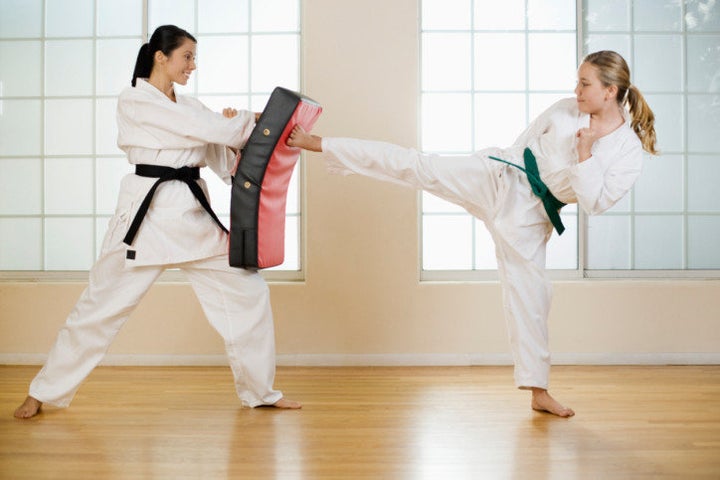
Whether you're thinking of getting involved in martial arts or have already begun, you can improve your health and pave the way to preventing future medical problems, all while having fun learning non-violent self-defense. The martial arts all have different traditions, philosophies and styles. Since they are often based on ancient philosophy, no matter which one you choose, there is usually a spiritual element and the possibility for inner growth.
Tai Chi
A lot of scientific research has been done on the benefits of Tai Chi, which has roots in Taoism and Confucianism and is practiced by all age groups worldwide. Form is everything for this sequence of movements. Though it is active, it is also slow and controlled, and renowned for its health benefits, particularly for older people and those with chronic conditions. The orderly sequence of movements helps to improve balance, coordination and flexibility. It also requires concentration and focus, which can aid memory. For those who have a hard time just getting up off the couch, or for those who can't do aerobic exercise for any reason, Tai Chi can provide a wonderful way to get moving.
What it helps: Studies show that Tai Chi, like some of the other martial arts, promotes calmness and relaxation, while also helping participants to slow their breathing. This may lead to lower blood pressure. This is especially beneficial for older practitioners, but low blood pressure is good for everyone, and slow breathing may help more than fast breathing in oxygenating the blood. The continuous movements of Tai Chi that increase flexibility have also been shown to reduce the pain of arthritis and improve general physical function and overall health. Tai Chi can potentially provide enough exercise to help lower bad cholesterol.
What it prevents: The postural elements of Tai Chi may contribute to the prevention of backache, stiff neck, gastric reflux, dangerous falls and Dowager's hump. Studies have shown that Tai Chi can help post-menopausal women reduce loss of muscle strength and muscle mass.
More information: American Tai Chi and Quigong Association
Aikido
This self-defense art is meant to be used in a way so that it also protects an attacker from injury, and therefore enables a confrontation to end peacefully. When someone enters your space, you're centered and ready when practicing Aikido. Your opponent, however, is not centered. When your challenger strikes, your movements redirect that person's energy. The harder and faster the attack, the worse off the attacker is. Aikido is not as slow as Tai Chi and not as high-velocity as Taekwondo.
Training for Aikido involves improving general physical fitness, but students also learn to throw opponents. That's why it's important for those who practice this martial art to be able to fall and roll without hurting themselves. The physical training in Aikido is diverse, covering joint locks, throws and submission holds while and preparing students to defend themselves against more than one attacker. In general Aikido teaches smooth use of the whole body.
What it helps: Aikido is good for balance, reflexes, calmness and for overall health.
What it prevents: Surprisingly, clinical trials have found that martial arts do not promote aggression or violence. On the contrary, martial arts promote non-violence and are recommended for at-risk youth.
Cautions: Though more studies specific to Akido are needed, the most common martial arts injuries occur on the wrists, hands, fingers, feet, knees, head and thighs.
More information: United States Aikido Association
Taekwondo
This Korean martial art, the national sport of Korea, has also been a competitive Olympic sport since 2000. It's aerobic, requires athleticism and is high-velocity. Part of the workout involves using high kicks, punches and strikes meant to develop strength, speed and survival skills. Unlike Aikido, it's not defensive -- it's offensive. The workout is fast-paced and has aerobic elements. People who practice Taekwondo sometimes demonstrate exciting feats, such as breaking a whole stack of wooden planks or tiles with one blow. But Taekwondo does more than develop strength -- it can enhance balance, flexibility and stamina. And it can also help participants increase their speed of response. In short, it's good for overall health.
What it helps: Taekwondo, like Tai Chi and Aikido, is good for kids and adolescents of both genders. It provides a healthy and focused release of energy and teaches discipline, concentration and respect for others. In spite of its high activity level, it necessitates concentration. It's good for blood pressure, cholesterol levels and weight loss. And a study done in Hong Kong found (though more research is needed) that Taekwondo is
beneficial for overall fitness. A study of the effects of Taekwondo on adolescent females who don't get much other exercise also showed that, rather quickly, this type of training can produce beneficial changes in skeletal muscle fitness, flexibility and body composition.
What it prevents: Since the speed of your reflexes are enhanced, all sorts of accidents can be avoided. Taekwondo can do everything from help a driver swerve away from an accident to keep you for from falling if you trip or step in a pothole.
Cautions: Studies show that participating in Taekwondo can be
stressful, especially for children. And while injuries aren't common -- one study found 0.3 percent of women were injured and 1.2 percent of men sustained some injury while doing martial arts -- fractures of lower limbs were the most common injuries. Tearing of the ligaments in the knee is also possible, and kicks and punches can cause head injury. Just a few days ago I treated a gentleman who had a stress fracture in his lumbar spine and quadraceps tendonitis of the hip sustained while doing Taekwondo. And while monitoring an Olympic qualifying event in Boston, I took care of a man who dislocated his finger so badly while blocking a kick that the bone was sticking out. Mouthguards, kneepads and other protective gear can be useful for preventing some injuries.
More information: American Taekwondo Association